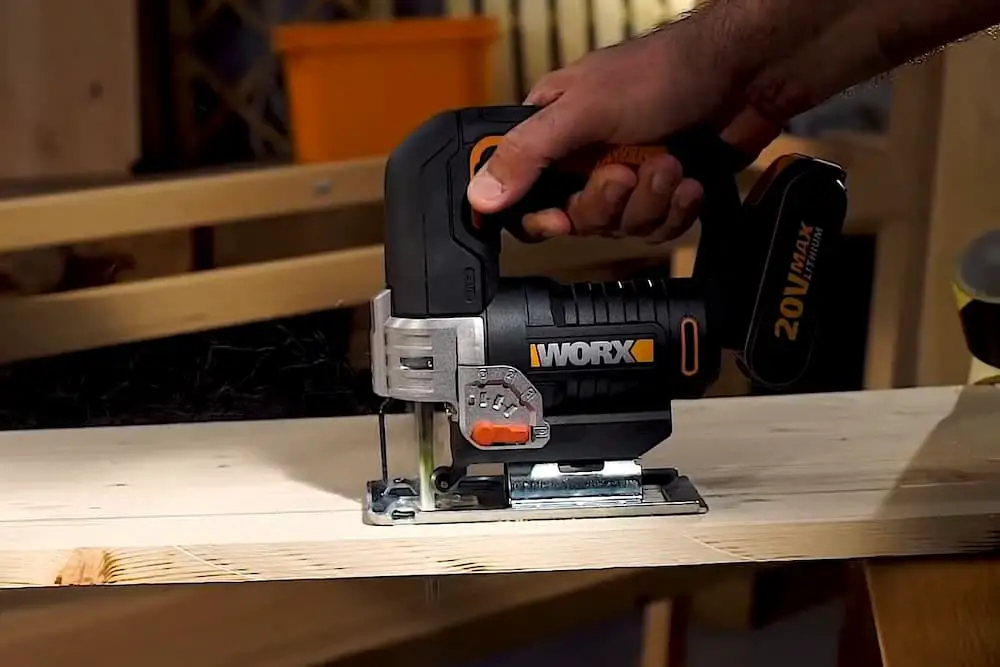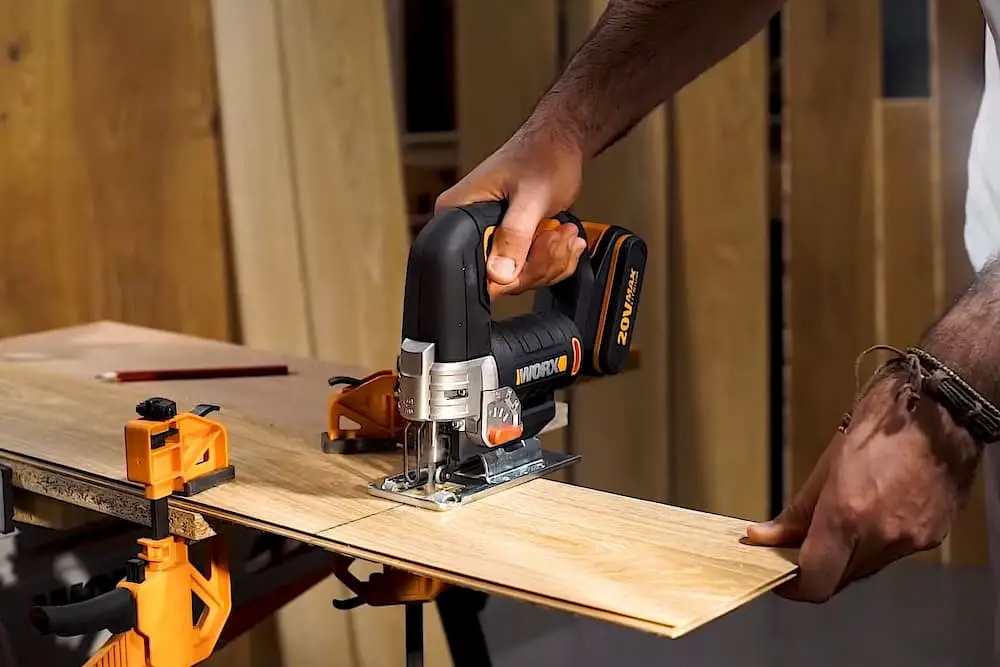Cutting laminate can be a tricky task, especially if you don’t have the right jigsaw blade. A blade that isn’t designed for this purpose can lead to chipping, rough edges, and other imperfections in your work.
To achieve a smooth and clean cut, it’s crucial to choose a blade specifically designed for cutting laminate materials. In this blog post, we will discuss the features you should look for in a jigsaw blade to cut laminate flooring and countertops.
Additionally, we will provide some top recommendations based on user experiences, ensuring you get the best possible results for your project.
Features to Look for in a Jigsaw Blade for Laminate
When choosing a jigsaw blade for cutting laminate materials, there are several essential features to consider. These features will help ensure a clean, precise cut and minimize potential damage to your laminate flooring or countertops:
- High Teeth Per Inch (TPI): Aim for at least 20 TPI for a smoother cut and less chipping. Higher TPI blades generally provide cleaner cuts, making them ideal for laminate materials.
- Ground Teeth: Unlike set teeth that alternate directions, ground teeth are all lined up facing the same direction, resulting in cleaner cuts with less tearing and chipping.
- Reverse-Tooth Design: These blades cut on the downstroke, minimizing chipping on the top side of the laminate. This design is especially useful for cutting through laminate surfaces where a clean edge is critical.
- Carbide-Tipped or Bi-Metal Teeth: Carbide-tipped blades usually offer the smoothest cuts, but bi-metal blades are a more affordable option and still work well for laminate. Both types of blades are durable and long-lasting, making them suitable for cutting through tough laminate materials.
- Uncoated: While some manufacturers coat their blades to match their brand, uncoated blades are better for thicker cuts where there’s less risk of paint transfer. This helps ensure a clean cut without the risk of color contamination.
- Blade Length: Ensure that your blade has at least a quarter-inch of clearance on the bottom of your workpiece. This allows for proper cutting depth and prevents potential damage to your jigsaw or work surface.
- Blade Thickness: Thicker blades are more rigid and can help prevent bending or flexing during the cutting process, which is especially important when cutting through laminate materials. A rigid blade will help maintain a straight and clean cut, reducing the risk of damage or imperfections.
Now that we’ve discussed the essential features to look for in a jigsaw blade for laminate, let’s explore some top recommendations based on user experiences. These blades have been chosen for their performance, durability, and ability to deliver clean cuts in laminate materials.

Top Jigsaw Blade Recommendations for Cutting Laminate
These are the 3 recommended blades for cutting laminate flooring and countertops.
Recommended blade #1 – BOSCH T101AO
The BOSCH T101AO jigsaw blade is a top choice for cutting laminate floors and countertops, as well as various other materials such as double-sided laminates, laminated substrates, MDF, hard and soft woods, and plywood. Its pointed teeth reduce splintering on both sides of the workpiece, and the 20 TPI pointed tooth profile and narrow blade body are optimized for clean, curved cuts and scrolling. Users have praised the blade’s durability and cutting performance, noting that it provides a smooth and clean cut, even on veneered products. However, some users have reported that the blade can produce a high-pitched noise when used at high speeds.
Key features:
- 20 TPI pointed tooth profile for clean and smooth cuts
- Pointed teeth to reduce splintering on both sides of the workpiece
- Suitable for use on double-sided laminates, laminated substrates, MDF, hard and soft woods, and plywood
- T-shank design for better durability and longer life
- 5-pack of jig saw blades for added value
- 3 inches long for sufficient cutting capacity
- Ideal for fine finish, veneers, and laminates
Pros and cons:
Pros:
- High-quality, clean cuts on a variety of materials
- Reduced splintering due to pointed teeth design
- Durable and long-lasting T-shank design
- Suitable for fine finishes, veneers, and laminates
Cons:
- High-pitched noise produced at high speeds
Recommended blade #2 – Bosch T128BHM3
The Bosch T128BHM3 jigsaw blade is a durable and versatile option for cutting high-pressure laminate materials, including laminate flooring. Its carbide brazing technology offers 10x longer life compared to standard bi-metal blades, and the advanced tooth design ensures clean cuts in difficult-to-cut, brittle materials on both sides of the cutting surface. The blade’s thin kerf reduces material extraction and heat, contributing to its overall performance. Users have praised the blade’s ability to punch down into the center of a piece of laminate flooring without breaking, thanks to its pointed tip and strong steel body.
Key features:
- Carbide brazing technology for 10x longer life compared to standard bi-metal blades
- Advanced tooth design for clean cuts in brittle materials
- Thin blade kerf for reduced material extraction and heat
- 14 TPI for extra-clean, chip-free cuts
- Designed specifically for high-pressure laminates
- 3.62 inches long with 36 teeth per blade
- Two rows of counter-directed teeth for clean cuts in laminates and laminate flooring
Pros and cons:
Pros:
- Long-lasting, durable carbide brazing technology
- Designed specifically for cutting high-pressure laminates
- Clean, chip-free cuts due to advanced tooth design and counter-directed teeth
- Reduced heat and material extraction with thin blade kerf
- Pointed tip and strong steel body for added durability
- Capable of withstanding nail hits without requiring blade change-outs
- Ideal for both building and installing laminate materials
Cons:
- Slightly lower TPI compared to some other options (14 TPI), which may impact the smoothness of the cut in some cases
- May not be as suitable for cutting non-laminate materials as some other blades
Recommended blade #3 – DEWALT DW3762H
The DEWALT DW3762H is a high-quality jigsaw blade designed for cutting laminate materials with precision and minimal chipping. This 4-inch, 10 TPI laminate down-cutting blade is well-regarded for its long-lasting sharpness and clean cutting capabilities. Users have praised its performance in various laminate flooring projects and its compatibility with both Bosch and DEWALT jigsaws.
Key features
- Precision ground teeth for staying sharp longer and delivering smooth, clean cuts
- Deeper gullets with increased free space for faster material removal and cutting
- T-shank design compatible with all Bosch and DEWALT jig saws
- Designed specifically for laminate cutting, minimizing chipping and delivering a clean finish
Pros and cons
Pros:
- Consistently provides clean cuts in laminate materials, with minimal chipping
- Compatible with both Bosch and DEWALT jigsaws, offering versatility
- Durable and maintains its sharpness over time
- Effective for various laminate applications, including flooring and countertops
Cons:
- May dull more quickly when used extensively on laminate flooring projects, requiring additional blade replacements
- Lower TPI (10 TPI) compared to some other options, which could impact the smoothness of the cut in certain cases

Frequently Asked Questions
What is the best TPI for cutting laminate flooring?
The best TPI (teeth per inch) for cutting laminate flooring is generally around 20 TPI or higher. Higher TPI blades provide smoother cuts and reduce the likelihood of chipping or splintering, which is important when working with laminate materials.
What Dewalt jigsaw blade for laminate flooring?
The DEWALT DW3762H is a popular jigsaw blade for cutting laminate flooring. This 4-inch, 10 TPI down-cutting blade is designed specifically for laminate materials and offers precision ground teeth that stay sharp longer, delivering smooth and clean cuts.
Do you cut laminate flooring upside down with jigsaw?
When using a jigsaw to cut laminate flooring, it’s best to cut with the laminate face up if you’re using a reverse-tooth blade, which cuts on the downstroke. This helps minimize chipping on the top side of the laminate, ensuring a cleaner finish.
Is laminate flooring hard on saw blades?
Yes, laminate flooring can be hard on saw blades due to its composition, which often includes abrasive materials like aluminum oxide. This abrasiveness can cause saw blades to dull more quickly than when cutting softer materials, such as wood. To combat this, opt for carbide-tipped or bi-metal blades designed for cutting laminate.
Do you cut laminate face up or face down?
Whether you cut laminate face up or face down depends on the type of blade you’re using. If you’re using a standard blade that cuts on the upstroke, you should cut laminate face down to minimize chipping on the visible side. If you’re using a reverse-tooth blade that cuts on the downstroke, you should cut laminate face up. This will ensure that any chipping or splintering occurs on the backside of the laminate, leaving the visible side with a cleaner finish. Always follow the manufacturer’s recommendations for the specific blade you are using to achieve the best results.
Conclusion
Choosing the right jigsaw blade for cutting laminate is essential to achieving a professional and polished result. Make sure to prioritize features like high TPI, ground teeth, reverse-tooth design, and carbide-tipped or bi-metal construction when selecting a blade to ensure clean, precise cuts with minimal chipping. Our top recommendations are a great starting point, but keep in mind that the ideal blade for your specific needs and budget may vary. Happy cutting and best of luck with your laminate project!
